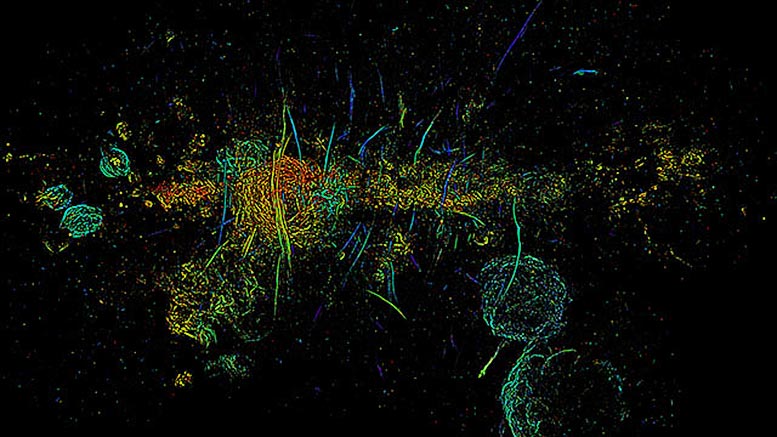Unprecedented New Telescope Image Reveals Nearly 1,000 Mysterious Strands in Milky Way’s

A mosaic image of the center of the Milky Way, captured with radiowaves. The magnetic filaments are large, vertical slashes throughout the image. Credit: Northwestern University
‘A watershed in furthering our understanding of these structures,’ researcher says.
An unprecedented new telescope image of the 
Farhad Yusef-Zadeh. Credit: Northwestern University
“We have studied individual filaments for a long time with a myopic view,” said Yusef-Zadeh, the paper’s lead author. “Now, we finally see the big picture — a panoramic view filled with an abundance of filaments. Just examining a few filaments makes it difficult to draw any real conclusion about what they are and where they came from. This is a watershed in furthering our understanding of these structures.”
Yusef-Zadeh is a professor of physics and astronomy at Northwestern’s Weinberg College of Arts and Sciences and a member of the Center for Interdisciplinary Exploration and Research in Astrophysics (CIERA).
Constructing the image
To construct the image with unprecedented clarity and detail, astronomers spent three years surveying the sky and analyzing data at the South African Radio Astronomy Observatory (SARAO). Using 200 hours of time on SARAO’s MeerKAT telescope, researchers pieced together a mosaic of 20 separate observations of different sections of the sky toward the center of the Milky Way galaxy, 25,000 light years from Earth.
The full image will be published in an additional, accompanying paper[2] — led by Oxford University astrophysicist Ian Heywood and co-authored by Yusef-Zadeh — in a forthcoming issue of The Astrophysical Journal. Along with the filaments, the image captures radio emissions from numerous phenomena, including outbursting stars, stellar nurseries and new supernova remnants.
“We have studied individual filaments for a long time with a myopic view. Now, we finally see the big picture — a panoramic view filled with an abundance of filaments. This is a watershed in furthering our understanding of these structures.”
— Farhad Yusef-Zadeh, astrophysicist
“I’ve spent a lot of time looking at this image in the process of working on it, and I never get tired of it,” Heywood said. “When I show this image to people who might be new to radio astronomy, or otherwise unfamiliar with it, I always try to emphasize that radio imaging hasn’t always been this way, and what a leap forward MeerKAT really is in terms of its capabilities. It’s been a true privilege to work over the years with colleagues from SARAO who built this fantastic telescope.”
To view the filaments at a finer scale, Yusef-Zadeh’s team used a technique to remove the background from the main image in order to isolate the filaments from the surrounding structures. The resulting picture astounded him.
“It’s like modern art,” he said. “These images are so beautiful and rich, and the mystery of it all makes it even more interesting.”
What we know
While many mysteries surrounding the filaments remain, Yusef-Zadeh has been able to piece together more of the puzzle. In their latest paper, he and his collaborators specifically explored the filaments’ magnetic fields and the role of cosmic rays in illuminating the magnetic fields.
The variation in radiation emitting from the filaments is very different from that of the newly uncovered supernova remnant, suggesting that the phenomena have different origins. It is more likely, the researchers found, that the filaments are related to past activity of the Milky Way’s central supermassive 
Harp-like cluster. Credit: Northwestern University
“They almost resemble the regular spacing in solar loops,” he said. “We still don’t know why they come in clusters or understand how they separate, and we don’t know how these regular spacings happen. Every time we answer one question, multiple other questions arise.”
Yusef-Zadeh and his team also still don’t know whether the filaments move or change over time or what is causing the electrons to accelerate at such incredible speeds.
“How do you accelerate electrons at close to the speed of light?” he asked. “One idea is there are some sources at the end of these filaments that are accelerating these particles.”
What’s next
Yusef-Zadeh and his team are currently identifying and cataloging each filament. The angle, curve, magnetic field, spectrum and intensity of each filament will be published in a future study. Understanding these properties will give the astrophysics community more clues into the filaments’ elusive nature.
The MeerKAT telescope, which launched in July 2018, will continue to unveil new secrets.
“We’re certainly one step closer to a fuller understanding,” Yusef-Zadeh said. “But science is a series of progress on different levels. We’re hoping to get to the bottom of it, but more observations and theoretical analyses are needed. A full understanding of complex objects takes time.”
References:
- “Statistical Properties of the Population of the Galactic Center Filaments: The Spectral Index and Equipartition Magnetic Field” by F. Yusef-Zadeh, R. G. Arendt, M. Wardle, I. Heywood, W. D. Cotton and F. Camilo, Accepted, The Astrophysical Journal Letters.
arXiv:2201.10552 - “The 1.28 GHz MeerKAT Galactic Center Mosaic” by I. Heywood, I. Rammala, F. Camilo, W. D. Cotton, F. Yusef-Zadeh, T. D. Abbott, R. M. Adam, G. Adams, M. A. Aldera, K. M. B. Asad, E. F. Bauermeister, T. G. H. Bennett, H. L. Bester, W. A. Bode, D. H. Botha, A. G. Botha, L. R. S. Brederode, S. Buchner, J. P. Burger, T. Cheetham, D. I. L. de Villiers, M. A. Dikgale-Mahlakoana, L. J. du Toit, S. W. P. Esterhuyse, B. L. Fanaroff, S. February, D. J. Fourie, B. S….
Read More: Unprecedented New Telescope Image Reveals Nearly 1,000 Mysterious Strands in Milky Way’s

